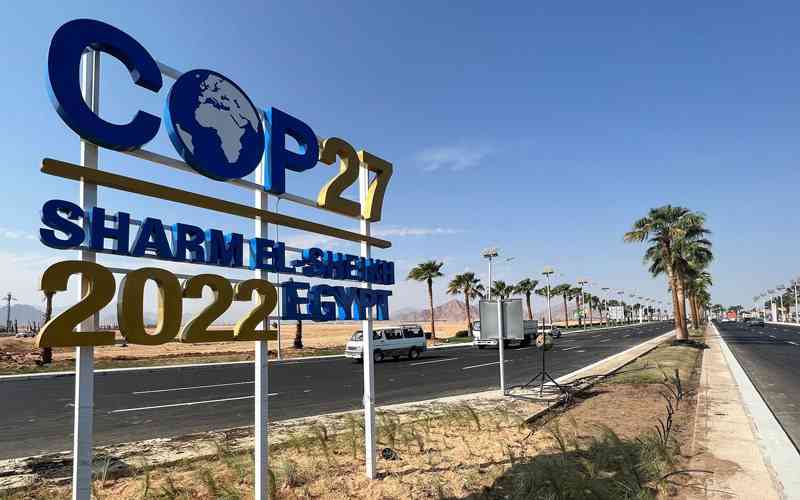
THE United Nations Framework Convention on Climate Change (UNFCCC) conference of parties (COP27) has come and gone hence it is time for the parties and everyone involved to introspect, reflect, take stock and evaluate in order to map the way forward.
From the onset, COP27 was never going to be easy considering the cat and mouse relations between developed and developing countries. Emotions were likely to be higher but mind you this was a gathering where neither facts nor reality mattered most but self-interest and diplomacy. At the end of the day, it was politics that triumphed over the environment as was witnessed by the skirting over of issues of carbon emissions together with communication-massaging on the outcome of the loss and damage sticking point.
The events that lead to COP27, witnessed slow progress, with rich countries blocking progress on the sticking issue of loss and damage. While the developing countries wanted loss and damage to be placed at the top of COP27 agenda, rich nations dilly-dallied, played mind and linguistic games. For this reason, green campaigners around the world were concerned as they were quick to raise the red flag. Quite numerous preparations were held around the north and south with the developing countries maintaining their stance on climate-induced loss and damage as a humanitarian crisis.
Some of the obvious successes and breakthroughs hinged on embracing scientific evidence and urgently implementing bold mitigation and adaptation measures to curb looming climate disasters. The issue of loss and damage including carbon emissions resulting from fossil fuel burning remained contested and sticking issues on the part of developed countries as they involved reparations or compensation for wide-scale losses and damage incurred by developing countries.
The last minute agreement and pledge for payment of losses and damage incurred by the developing countries still remains a contested issue in the absence of commitment towards reducing temperatures realised from burning fossil fuels. Yes, there was a breakthrough but with outstanding issues with regard to carbon emissions.
In this regard, what it means is that rich countries will continue to shoulder the responsibilities for their pollutions for quite some time.
COP27 in Sharm el Sheikh, Egypt is not the last UNFCCC conference of parties, therefore it is still a process and hope should not be lost but we expect more climate games, trickery, machinations and greenwashing from those countries skilled in the game of emissions.
While developing countries expect main polluting actors to tone down on their emissions, the G77 countries are also trying their hand at the exploration for oil and gas, the same substances which we wish to see being eradicated or kept underground. Then it becomes an issue of ambivalences where both sets of parties are speaking in riddles.
- Zanu PF looks down on Tonga people: MP
- Africa must forgo gas exploration to avert climate disaster, warn experts
- Africa must forgo gas exploration to avert climate disaster, warn experts
- AfDB approves Energy Access Finance Framework
Keep Reading
There is still more work to be done on a serious note for developing countries to realise their goals and outcomes which means that engagements, concessions and sensitisation should continue to be done.
How the compensation and reparation programme is going to be drawn or the formula that is going to be used in paying for losses and damage is not known yet. If the compensation is going to be released the Green Climate Fund way, then we are not going anywhere. Already we have witnessed developed countries making sporadic announcements depending on what they feel like offering. This becomes problematic because there are no compelling rules and guidelines to be followed when making these reparations.
Since loss and damage issues are context based and essentially localised, it remains to be seen what benchmarks, parameters and criteria will be used to determine the nature of funding.
This also includes which countries will be given funding first and by how much. Of course, some countries are good guys not blue-eyed, but are just favoured over others, its natural and it will always happen that way, those are the vicissitudes of climate finance.
What it also means is that on top of other forms of climate finance, loss and damage has also added another funding burden. This is what developed countries wanted to avoid at all costs and the reason they proposed climate insurance.
Out of their own volition, that is why to date only a handful of developed countries have tested the waters by releasing a few millions of dollars while the majority of main polluting actors are yet to follow suit.
The other sticking issue, is the realisation that not all forms of loss and damage are climate induced, some are not and how will they be contextualised in order to attract funding.
This is still a process but it does not need another COP to iron out, maybe a committee or a taskforce of some sort will do the job while recipients of loss and damage funding change their behaviours too because they are in the habit of receiving without being accountable.
Even when the loss and funding facility comes into effect and developing nations receive their tranches, it remains to be seen whether the money will be used for its purpose. This is because financial abuse is within the DNA of most developing countries while shooting themselves in the foot is a known norm.
These envisaged climate solutions require systems changes. It is difficult for a leopard to shed off its spots, but gradually, change will come. The existential threat caused by climate change should be appropriately managed.
Peter Makwanya is a climate change communicator. He writes in his personal capacity and can be contacted on: [email protected]








